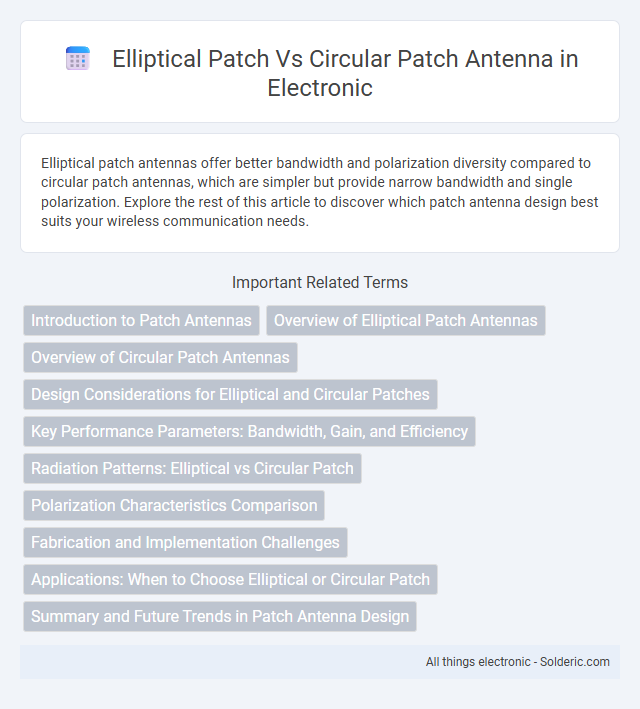Elliptical patch antennas offer better bandwidth and polarization diversity compared to circular patch antennas, which are simpler but provide narrow bandwidth and single polarization. Explore the rest of this article to discover which patch antenna design best suits your wireless communication needs.
Comparison Table
| Feature | Elliptical Patch Antenna | Circular Patch Antenna |
|---|---|---|
| Shape | Elliptical | Circular |
| Bandwidth | Moderate, can be optimized via axis ratio | Narrow to moderate |
| Polarization | Supports linear and circular polarizations | Supports linear and circular polarizations |
| Radiation Pattern | Directional with slight beamwidth variation | Omnidirectional in azimuth plane |
| Size | Compact, adjustable by ellipse axes | Compact, radius defines size |
| Application | Wireless communication, GPS, radar systems | Wireless communication, RFID, satellite links |
| Fabrication Complexity | Moderate due to elliptical geometry | Simple and cost-effective |
| Impedance Matching | Easier to achieve with proper feed placement | Standard feed techniques apply |
Introduction to Patch Antennas
Patch antennas, widely used in wireless communication, are microstrip antennas consisting of a radiating patch on one side of a dielectric substrate and a ground plane on the other. Elliptical patch antennas offer greater bandwidth and improved axial ratio compared to circular patch antennas, making them suitable for circular polarization applications. Circular patch antennas, known for their symmetrical radiation patterns and ease of fabrication, are commonly used in satellite and RFID systems but typically provide narrower bandwidth than elliptical designs.
Overview of Elliptical Patch Antennas
Elliptical patch antennas exhibit a unique geometry characterized by an elliptical radiating element, which enhances polarization purity and bandwidth compared to circular patch antennas. Their shape allows for improved impedance matching and reduced cross-polarization levels, making them ideal for applications requiring precise polarization control and wide frequency coverage. Elliptical patch antennas also offer a favorable trade-off between size and performance, making them suitable for compact wireless communication devices.
Overview of Circular Patch Antennas
Circular patch antennas feature a simple, circular radiating element that provides symmetric radiation patterns and easy fabrication, making them highly popular in wireless communication systems. Their resonant frequency depends primarily on the radius of the patch, allowing for precise control over bandwidth and polarization characteristics. Compared to elliptical patches, circular patch antennas typically offer more uniform current distribution and predictable performance in various applications.
Design Considerations for Elliptical and Circular Patches
Elliptical and circular patch antennas differ significantly in design considerations, with elliptical patches offering more flexibility in controlling polarization and bandwidth due to their variable axis ratios, while circular patches provide simpler geometry ideal for omnidirectional radiation patterns. Your choice depends on the desired antenna performance, frequency range, and space constraints, as elliptical designs often require more complex calculations and fabrication techniques. Optimizing the aspect ratio in elliptical patches enhances impedance matching and gain, whereas circular patches benefit from uniform current distribution and ease of integration in compact systems.
Key Performance Parameters: Bandwidth, Gain, and Efficiency
Elliptical patch antennas generally offer wider bandwidth compared to circular patch antennas due to their elongated shape, which supports multiple resonant frequencies. The gain of elliptical patches tends to be higher, especially in directional applications, while circular patches provide more uniform radiation patterns with moderate gain. Efficiency in elliptical patch antennas can be optimized through careful impedance matching, enhancing your antenna's overall performance in diverse communication systems.
Radiation Patterns: Elliptical vs Circular Patch
Elliptical patch antennas offer more directional radiation patterns compared to circular patch antennas, which typically produce broader, more omnidirectional patterns. The elliptical shape allows for tighter beamwidth control, enhancing gain and reducing interference in specific directions. Your choice between these antennas impacts the radiation coverage and signal quality depending on the application requirements.
Polarization Characteristics Comparison
Elliptical patch antennas exhibit improved axial ratio performance, providing more stable circular polarization compared to circular patch antennas, which often produce linear or less pure circular polarization. The elliptical shape allows for fine-tuning of the resonance modes, enhancing polarization control and reducing cross-polarization levels. This results in better polarization purity and improved performance in applications requiring circular polarization, such as satellite communications and GPS systems.
Fabrication and Implementation Challenges
Elliptical patch antennas present fabrication challenges due to their complex curvature, requiring precise etching and substrate alignment to maintain performance consistency. Circular patch antennas offer simpler fabrication processes with uniform dimensions, resulting in easier implementation and repeatability on standard printed circuit boards. Variations in elliptical geometries demand advanced simulation tools to predict impedance and radiation patterns, increasing design and manufacturing costs.
Applications: When to Choose Elliptical or Circular Patch
Elliptical patch antennas are ideal for applications requiring directional radiation patterns and enhanced polarization diversity, such as satellite communications and radar systems. Circular patch antennas are preferred for applications demanding omnidirectional coverage and compact design, commonly used in GPS and mobile communication devices. Your choice depends on whether you need focused signal transmission with low cross-polarization (elliptical) or broad, uniform coverage with simpler fabrication (circular).
Summary and Future Trends in Patch Antenna Design
Elliptical patch antennas offer improved bandwidth and polarization diversity compared to circular patch antennas, making them suitable for advanced wireless communication systems. Future trends in patch antenna design emphasize miniaturization, reconfigurable materials, and integration with IoT devices to enhance performance and adaptability. Your choice between elliptical and circular patches depends on specific application requirements, especially when balancing size, efficiency, and bandwidth.
elliptical patch vs circular patch antenna Infographic

 solderic.com
solderic.com